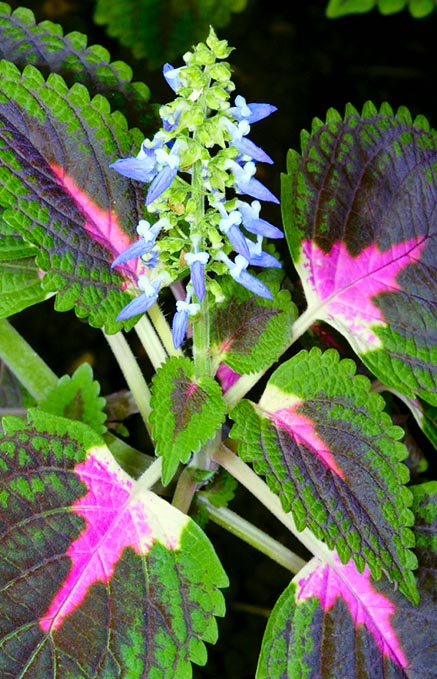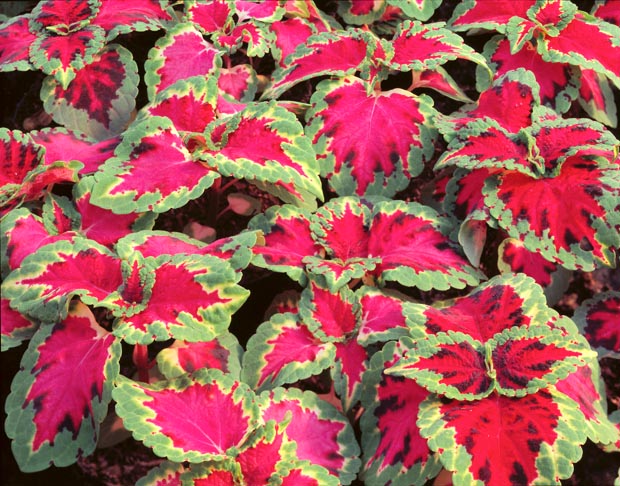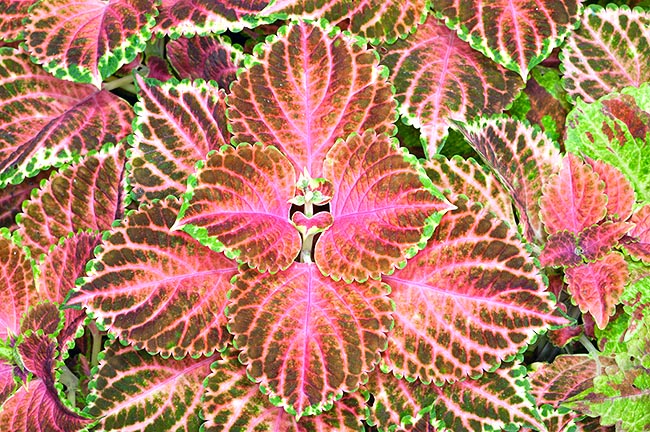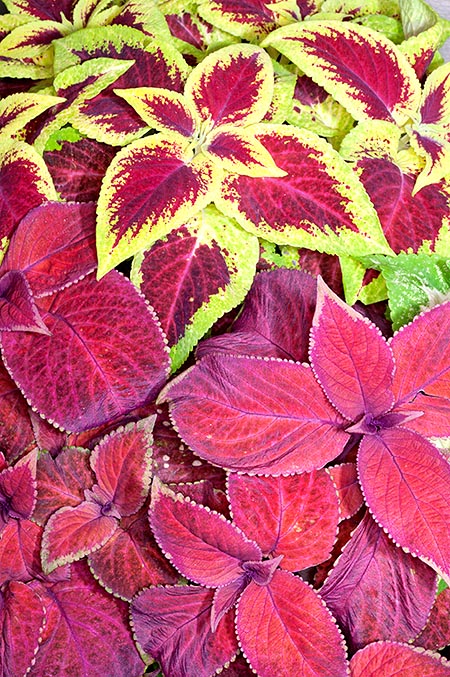Family : Lamiaceae

Text © Pietro Puccio

English translation by Mario Beltramini

The Plectranthus scutellarioides flower reminds us that it's a labiate © Mazza
The name of the genus is the combination of the Greek words “pléctron” = spur, and “anthos” = flower, with reference to the shape of the flower which, on the back, has an extension shaped like a spur.
The name of the species comes from the combination of Scutellaria, species belonging to the same family, and from the suffix “-oeidḗs”, from “êidos” = shape, look, similar, therefore, to a Scutellaria.
Common names: coleus, flame nettle, Jacob’s coat, painted nettle (English); coleo, coleus (Italian); vieux garçon (French); cóleus, coléus de Java, coração magoado (Portuguese); cóleo, coleus, cretona, goleo, macho, nene, tocador, vergüenza (Spanish); Buntblatt, Buntnessel (German).
The Plectranthus scutellarioides (L.) R.Br. (1810) is an evergreen perennial herbaceous plant with stems with an almost quadrangular section, tall up to about 90 cm, erect or ascending and hollow.
Tiny translucent hairs are present on the stem, branches, petioles and on the foliar lamina.
The leaves, quite variable in shape, dimension and colour, are opposite, with a usually ovate shape with toothed edges, 4-14 cm long.
The upper page is velvety, very small yellowish glands are present in the lower one.
The inflorescences in terminal cymes, up to 50 cm long, carry flowers with an about 1,2 cm long corolla, bilabiate, obtuse and trifid upper lip, of white or pale blue colour, the lower one, acute and semi-bifid, of violet blue colour.
On the outer surface of the corolla are present several glands and tiny hairs. The fruit is the typical fruit of the Lamiaceae, subdivided, when ripe, in four ovoid, about 1 mm long, achenes (indehiscent one-seeded dry fruits). It reproduces by seed in spring in peaty loam and sand in equal parts, covered by a thin layer, with constant humidity and at a temperature of 20-24 °C.

Born for the tropical forests, is suits also the temperate gardens and the domestic walls © Giuseppe Mazza
It easily roots in water too.
The first plant was introduced in Europe from Java in 1851 and has become quite popular in a very short time, not only for the vast variety of colours and variegations of the leaves, but also for its easy reproduction by cutting.
It may be utilized as garden plant, for edges, colour spots and soil cover, in the tropical, subtropical and, marginally, in the warm temperate climate zones, where the temperatures close to 0 °C are a short lasting exception, in a sheltered position.
It may bear the full sun, but filtered sun light or slight shade are preferable; it is not particular about the soil, provided well drained and kept constantly humid in summer.
Where the climate does not allow the permanent cultivation in open air, it may be cultivated as annual starting from seed or from cutting. Extremely popular as indoor plant for more than one century, during the last years its utilization has gotten a slight decline due to the massive offer of countless new varieties and species.

The stem has square section and from its cells cultivation they get the rosmarinic acid © Giuseppe Mazza
In order to maintain it in the best way, it is to be periodically pruned thus to inhibit the stems to become too long and for stimulating new ones, for a more compact posture.
The inflorescences, of poor ornamental value, must be chamfered upon their appearance, in order not to subtract any nourishment.
It may be useful to renew the plant after some years.
It is easily subject to cochineal and aphids attacks and is therefore to be periodically checked in order to quickly intervene. In the plant is present the rosmarinic acid which represents a defence against fungal diseases and parasites; this substance is pharmacologically considered as an anti-bacterial, anti-inflammatory and anti-oxidant.

The colour variations are countless as well as its synonyms © Giuseppe Mazza
Synonyms: Ocimum scutellarioides L. (1763); Germanea nudiflora Poir. (1778); Plectranthus nudiflorus (Poir.) Willd. (1800); Plectranthus aromaticus Roxb. (1814); Ocimum peltatum Schweigg. ex Schrank (1822); Plectranthus ingratus Blume (1826); Plectranthus laciniatus Blume (1826); Plectranthus scutellarioides Blume (1826); Coleus atropurpureus Benth. (1830); Coleus scutellarioides (L.) Benth. (1830); Coleus acuminatus Benth. (1831); Coleus blumei Benth. (1832); Coleus grandifolius Benth. (1832); Coleus ingratus (Blume) Benth. (1832); Coleus laciniatus (Blume) Benth. (1832); Coleus multiflorus Benth. (1832); Coleus secundiflorus Benth. (1832); Coleus grandifolius Blanco (1837); Coleus pumilus Blanco (1837); Coleus blancoi Benth. (1848); Perilla nankinensis Wender. (1859); Coleus verschaffeltii Lem. (1861); Coleus petersianus Vatke (1876); Majana acuminata (Benth.) Kuntze (1891); Majana blancoi (Benth.) Kuntze (1891); Majana grandifolia (Benth.) Kuntze (1891); Majana multiflora (Benth.) Kuntze (1891); Majana pumila (Blanco) Kuntze (1891); Majana scutellariodes (L.) Kuntze (1891); Majana secundiflora (Benth.) Kuntze (1891); Coleus gaudichaudii Briq. (1898); Coleus igolotorum Briq. (1898); Coleus savannicola K.Schum. (1900); Coleus formosanus Hayata (1906); Coleus pubescens Merr. (1909); Coleus crispipilus (Merr.) Merr. (1910); Coleus zschokkei Merr. (1910); Solenostemon blumei (Benth.) M.Gómez (1914); Coleus integrifolius Elmer (1915); Coleus gibbsiae S.Moore (1917); Coleus rehneltianus A. Berger (1917); Coleus hybridus Cobeau (1928); Plectranthus blumei (Benth.) Launert (1968); Solenostemon scutellarioides (L.) Codd (1975); Calchas acuminatus (Benth.) P.V.Heath (1996); Calchas crispipilus (Merr.) P.V.Heath (1996); Calchas atropurpureus (Benth.) P.V.Heath (1997); Calchas scutellarioides (L.) P.V.Heath (1999).
→ To appreciate the biodiversity within the family LAMIACEAE please click here.
